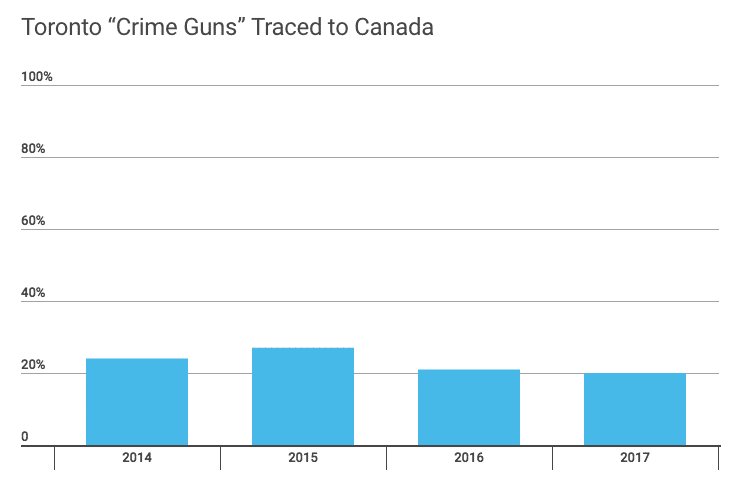
Only 20 percent of firearms, airguns, toy guns or replicas seized by the Toronto Police Service and deemed “crime guns” were traced to Canada in 2017, the least since at least 2014, according to calculations by TheGunBlog.ca based on police statistics. The earliest year available was 2014.
The data were sent by e-mail today by Meaghan Gray, a spokeswoman for the police, in response to questions from TheGunBlog.ca.
The figures were first reported last night by the Toronto Sun.
See the interactive charts below.
Read our second analysis on this topic with 11 years of data: More Than a Third of Toronto Police ‘Crime Guns’ Aren’t Firearms
Highlights: Toronto Police ‘Crime Gun’ Seizures 2017
- “Crime gun”: Any firearm, airgun, antique, starter pistol, toy gun, replica, etc. that police think was owned for crime, whether unlawful possession or a violent attack; any firearm with serial number removed. e.g., if a pellet gun or nail gun is used to rob a bank, it’s deemed a “crime gun.” About 31 percent of firearms seized by Toronto police each year are considered “crime guns.”
- 55%: Not traced because too old, too damaged, no serial number or not a firearm.
- 20%: Traced to a Canadian source in 2017, lowest level in at least 4 years.
- 50-50: Aggregating the positive traces from 2014 to 2017 shows near equality in foreign vs. Canada as the source of “crime guns.” The police said all foreign “crime guns” were traced to the U.S.
- Shift From 70-30: Police have said the 50-50 ratio is a shift from 70-30 several years ago. The data from earlier years weren’t available to share today.
!function(e,t,n,s){var i=”InfogramEmbeds”,o=e.getElementsByTagName(t)[0],d=/^http:/.test(e.location)?”http:”:”https:”;if(/^/{2}/.test(s)&&(s=d+s),window[i]&&window[i].initialized)window[i].process&&window[i].process();else if(!e.getElementById(n)){var a=e.createElement(t);a.async=1,a.id=n,a.src=s,o.parentNode.insertBefore(a,o)}}(document,”script”,”infogram-async”,”https://e.infogram.com/js/dist/embed-loader-min.js”);
Context & Questions
- The Toronto results are broadly in line with other findings from across the country.
- Investigators are unable to trace the majority of firearms seized from criminals because they are too old, too damaged or their serial numbers have been obliterated. Many firearm-like tools can’t be traced because they are unregulated.
- Of “crime guns” that are sourced positively, most are smuggled or stolen from the U.S. Only a third to a half of the guns that are successfully traced were illegally obtained from Canada.
- Some police extrapolate the results of successful traces to all “crime guns.” It’s unclear what justifies this.
- Criminals get guns in Canada by illegally buying or stealing them from private individuals, stores and police.
- At least four Toronto residents have been convicted since 2012 of buying firearms legally and then selling them illegally. One person unlawfully sold 43 handguns, 7 of which were recovered at crime scenes.
Bigger Picture
- Statistics Canada, March 2018: “What we don’t know: the origin of firearms involved in gun crime in Canada.”
- Knowing where criminals got their tools is useful, but secondary. “Where did he get the weapon?” is a lot easier to answer and a lot less important than “How do we build healthy communities with healthy people who live well together?”
Related Information
- CBC (Aug 2018): Canada Can’t Say Where Its Crime Guns Are Coming From
- Canadian Press (Jul 2018): Illegal Guns Sourced in Canada Are Surging, Compared to Those Smuggled From the U.S.
- Calibre (Nov 2017): Bulk of Crime Guns Domestically Sourced? Try 33%
- RCMP (2014) via Dennis Young: RCMP Firearms Operations and Enforcement Support Unit, 2014 Annual Report, Western Region
- Toronto Mayor John Tory in Toronto Sun (Mar 2018): Time to Stop Criminals From Getting Guns
- Toronto Star (Nov 2016): Toronto Police Memo Flags Surge in Domestic Handgun Trafficking
- Toronto Sun (Aug 2018): Bullets and Bloodshed: Smoke and Mirrors Won’t Stop Gangs and Guns
© 2018 TheGunBlog.ca
The most important part of gun rights isn’t “gun,” it’s “rights.”